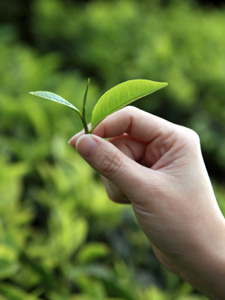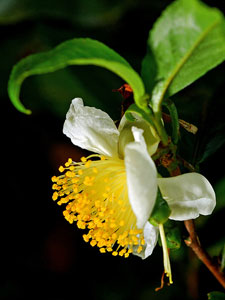Camellia sinensis


You've already learned the basics about tea, but in truth there is a lot of complexity that lies behind a Tea Master or Grower's search for the perfect cup. In this lesson we'll dig a little deeper into the amazing Camellia sinensis (cam-MEE-lee-ah sin-EN-sis) plant.
Camellia sinensis is part of the evergreen family. The leaves are glossy green with serrated edges. When allowed to flower (flowering is prevented during cultivation by harvesting the leaves, forcing the plant to constantly make more buds) the plant produces small white flowers with bright yellow stamens. The fruit that develops has a hard green shell and a single, round, brown seed. The seeds can be used to make tea oil.
Camellia sinensis comes in two primary varieties and a third, which is not typically used in tea cultivation. The Camellia sinensis sinensis plant strain is from China and is usually used to make green and white teas. Some black teas and oolong teas are also made using this variety. The Camellia sinensis assamica strain is native to the Assam region in India. This plant is usually used for black tea, as well as pu'erh tea in Yunnan province, China (in Yunnan, you can find ancient tea trees; these are Assamica variety, too). The third variety is Camellia sinensis cambodiensis (the "Java bush"). While it has been crossbred to achieve certain traits in other cultivars (ie: 'cultivated variety'), the Java bush is not typically used in commercial tea production. There are roughly 1,500 cultivars derived from the two main varieties, but we'll leave that for the tea growers.
Camellia sinensis sinensis (China)
The China plant grows best in cool temperatures on steep mountain slopes. In fact, it thrives at elevations up to 9,500 feet. Because of the climate and elevation, the China plant will typically grow to between 5 and 15 feet tall, if left unattended, and produce leaves up to two inches long. The short mountain growing seasons yield a smaller crop of more tender leaves that yield a sweeter, less astringent cup.
The China plant is typically pruned to be waist high with a flat top surface to allow easier plucking of the new growth. Because of the climate, the growing season is, at most, half of the year, and the plant will generally yield no more than five pluckings in a year. The China plant will be dormant during the winters. During this time, the plant is storing up its energy and nutrients and the first spring "flush" of new growth provides some of the finest teas on earth with the highest concentrations of desirable flavors and essential elements that provide the health benefits in tea.
Camellia sinensis assamica (Assam, India)
The Assamica (ah-SAH-mee-ka) strain is native to the Assam region in Northern India. High humidity, generous rainfall, and warm temperatures allow this larger, more robust tea variety to thrive. The Assamica plant will grow to between 30 and 60 feet if left unattended and produce much larger (up to 8 inches) leaves. Under perfect conditions with proper fertilization, the Assamica plant can be harvested every 8 to 12 days throughout the year. Because of the tremendous yields, it is the preferred crop in Northeast India, Sri Lanka and Africa. The unique climate in Sri Lanka allows the harvest from this hardy bush to continue year-round. The Assamica leaf is ideal for producing strong, malty, black teas. Other Chinese teas requiring lengthier production, such as oolong and pu'erh, are also made from the larger leaves of the Assamica plant.
 teaclass
teaclass
